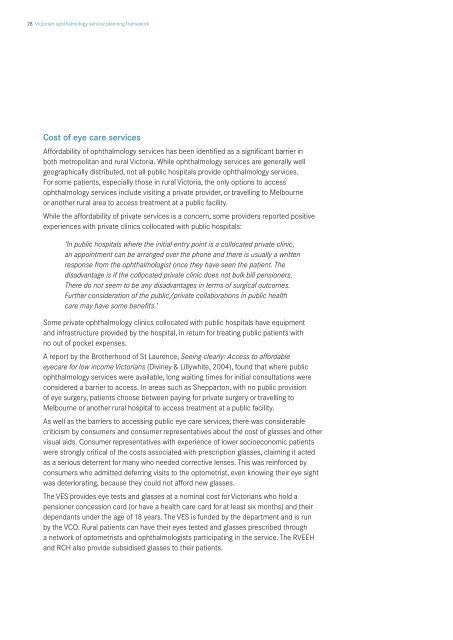Victorian ophthalmology service planning framework
Victorian ophthalmology service planning framework
Victorian ophthalmology service planning framework
You also want an ePaper? Increase the reach of your titles
YUMPU automatically turns print PDFs into web optimized ePapers that Google loves.
28 <strong>Victorian</strong> <strong>ophthalmology</strong> <strong>service</strong> <strong>planning</strong> <strong>framework</strong><br />
Cost of eye care <strong>service</strong>s<br />
Affordability of <strong>ophthalmology</strong> <strong>service</strong>s has been identified as a significant barrier in<br />
both metropolitan and rural Victoria. While <strong>ophthalmology</strong> <strong>service</strong>s are generally well<br />
geographically distributed, not all public hospitals provide <strong>ophthalmology</strong> <strong>service</strong>s.<br />
For some patients, especially those in rural Victoria, the only options to access<br />
<strong>ophthalmology</strong> <strong>service</strong>s include visiting a private provider, or travelling to Melbourne<br />
or another rural area to access treatment at a public facility.<br />
While the affordability of private <strong>service</strong>s is a concern, some providers reported positive<br />
experiences with private clinics collocated with public hospitals:<br />
‘In public hospitals where the initial entry point is a collocated private clinic,<br />
an appointment can be arranged over the phone and there is usually a written<br />
response from the ophthalmologist once they have seen the patient. The<br />
disadvantage is if the collocated private clinic does not bulk bill pensioners.<br />
There do not seem to be any disadvantages in terms of surgical outcomes.<br />
Further consideration of the public/private collaborations in public health<br />
care may have some benefits.’<br />
Some private <strong>ophthalmology</strong> clinics collocated with public hospitals have equipment<br />
and infrastructure provided by the hospital, in return for treating public patients with<br />
no out of pocket expenses.<br />
A report by the Brotherhood of St Laurence, Seeing clearly: Access to affordable<br />
eyecare for low income <strong>Victorian</strong>s (Diviney & Lillywhite, 2004), found that where public<br />
<strong>ophthalmology</strong> <strong>service</strong>s were available, long waiting times for initial consultations were<br />
considered a barrier to access. In areas such as Shepparton, with no public provision<br />
of eye surgery, patients choose between paying for private surgery or travelling to<br />
Melbourne or another rural hospital to access treatment at a public facility.<br />
As well as the barriers to accessing public eye care <strong>service</strong>s, there was considerable<br />
criticism by consumers and consumer representatives about the cost of glasses and other<br />
visual aids. Consumer representatives with experience of lower socioeconomic patients<br />
were strongly critical of the costs associated with prescription glasses, claiming it acted<br />
as a serious deterrent for many who needed corrective lenses. This was reinforced by<br />
consumers who admitted deferring visits to the optometrist, even knowing their eye sight<br />
was deteriorating, because they could not afford new glasses.<br />
The VES provides eye tests and glasses at a nominal cost for <strong>Victorian</strong>s who hold a<br />
pensioner concession card (or have a health care card for at least six months) and their<br />
dependants under the age of 18 years. The VES is funded by the department and is run<br />
by the VCO. Rural patients can have their eyes tested and glasses prescribed through<br />
a network of optometrists and ophthalmologists participating in the <strong>service</strong>. The RVEEH<br />
and RCH also provide subsidised glasses to their patients.

















